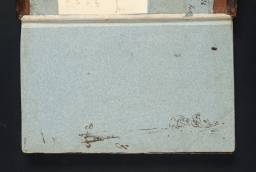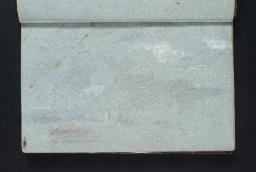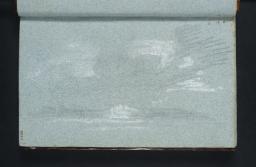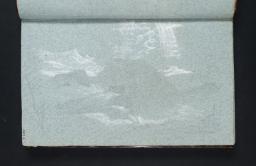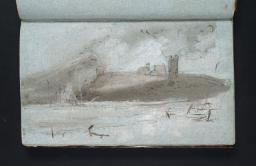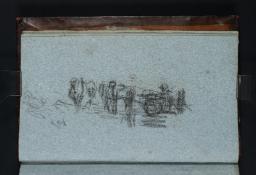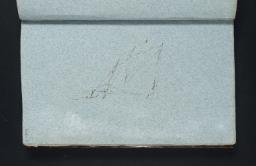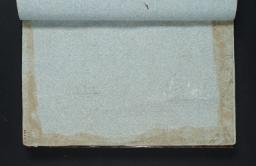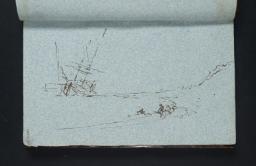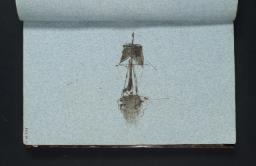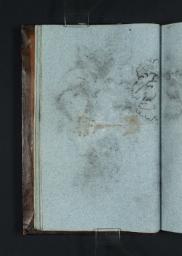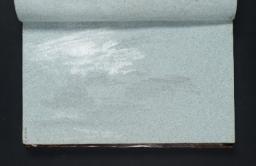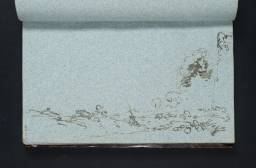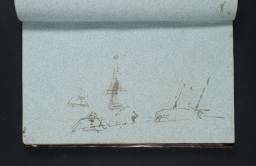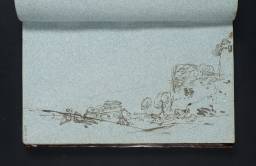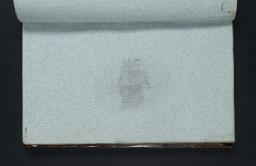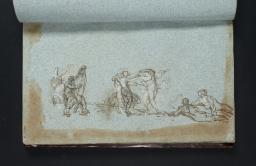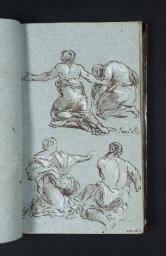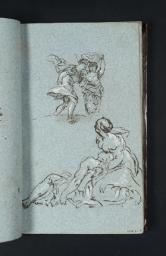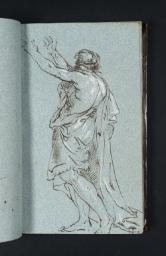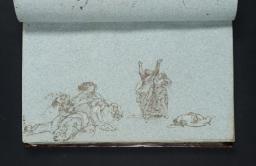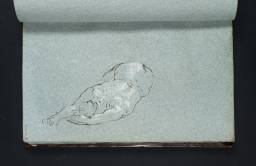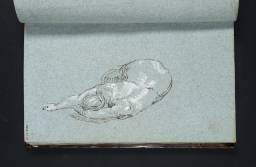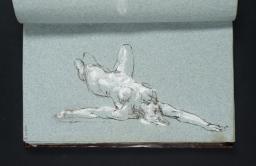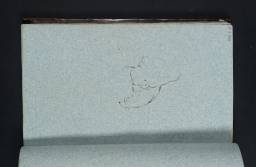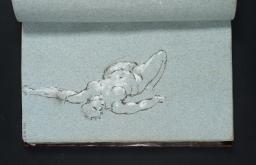Turner Bequest LXIX 1–131a
Sketchbook bound in boards covered in calf leather, with gold-tooled edges and spine
130 leaves, and 1 (D04101; Turner Bequest LXIX 87) now bound as inside back cover, of blue laid paper, 210 x 135 mm; watermark: Strasburg lily
Inscribed by Turner in black ink ‘Shipping’ on back cover (D40590)
Numbered 346 as part of the Turner Schedule in 1954, and endorsed by the Executors of the Turner Bequest, Charles Turner, Charles Lock Eastlake and John Prescott Knight in ink ‘No 346 Contains 88 | Sketches in Pencil Pen Ink | & Chalk C Turner’ and in pencil ‘C.L.E.’ and ‘JPK’ inside front cover towards top
Inscribed by John Ruskin in ink ‘346. | Book of grey paper, with | valuable but very slight early | studies. Most of them cut out | and mounted. Several had | been cut out by Turner and | were among the loose sketches.’ on white wove paper label cut from his wrapper for the sketchbook, pasted inside front cover below endorsement
Inscribed in black ink ‘88’ or ‘SS’ inside front cover, top right
Blind-stamped with Turner Bequest monogram inside front cover, towards top centre
Inscribed in pencil ‘LXIX’ inside front cover, top left
Stamped in black ‘LXIX’ inside front cover, top left
130 leaves, and 1 (D04101; Turner Bequest LXIX 87) now bound as inside back cover, of blue laid paper, 210 x 135 mm; watermark: Strasburg lily
Inscribed by Turner in black ink ‘Shipping’ on back cover (D40590)
Numbered 346 as part of the Turner Schedule in 1954, and endorsed by the Executors of the Turner Bequest, Charles Turner, Charles Lock Eastlake and John Prescott Knight in ink ‘No 346 Contains 88 | Sketches in Pencil Pen Ink | & Chalk C Turner’ and in pencil ‘C.L.E.’ and ‘JPK’ inside front cover towards top
Inscribed by John Ruskin in ink ‘346. | Book of grey paper, with | valuable but very slight early | studies. Most of them cut out | and mounted. Several had | been cut out by Turner and | were among the loose sketches.’ on white wove paper label cut from his wrapper for the sketchbook, pasted inside front cover below endorsement
Inscribed in black ink ‘88’ or ‘SS’ inside front cover, top right
Blind-stamped with Turner Bequest monogram inside front cover, towards top centre
Inscribed in pencil ‘LXIX’ inside front cover, top left
Stamped in black ‘LXIX’ inside front cover, top left
Accepted by the nation as part of the Turner Bequest 1856
Exhibition history
References
Like other books that Turner used to work out compositions, for instance the Dolbadarn and Studies for Pictures: Isleworth books of 1799 and about 1804–7 respectively (Tate; Turner Bequest XLVI, XC), this sketchbook provides a wide-ranging insight into his creative processes. The book was in use over a period when he felt himself particularly challenged to excel: the years of his election first as Associate of the Royal Academy, on 31 December 1799, and as full Academician on 12 February 1802. Accordingly, subject matter of several types is to be found – landscape, historical and marine – with paintings in view to be executed in both oil and watercolour, and sometimes with the final medium not yet determined. Finberg dated it to 1800–2,1 but it seems reasonable to suppose that it was brought into use a little earlier; see for instance the record of a painting by Claude Lorrain (1604/5–1682) that he is known to have seen in May 1799, on folio 121 recto (D04139; Turner Bequest LXIX 122). It seems likely, too, that some of the ideas developed here were noted soon after his return from North Wales in September–October 1799.
The blue (or ‘grey’) laid paper of this book recurs in the Egyptian Details sketchbook, which contains a brown ink and wash seascape (Tate D03834; Turner Bequest LXVI 2) like those here, and studies of plants (compare folio 113 recto of the present book; D04130; Turner Bequest LXIX 114) and ancient artefacts, some of which are executed in the cursive pen outline used in several figure studies here. Similar paper forms the Calais Pier sketchbook (Tate; TB LXXXI) where, as here, many studies are executed in black and white chalks, media that Turner adopted especially when he was working out his more ambitious ideas. He seems to have had in mind the traditional materials of artists from the Renaissance onwards, who typically planned their pictures in monochrome chalks on blue. Likewise, the rough pencil sketches of shipping on folios 32 verso–33 recto (D04027–D04028) to 42 recto (D04046) and 53 verso–54 recto (D04058–D04059) to 57 verso–58 recto (D04065–D04066), slight as they are, seem to have been made with an awareness of the shipping studies of Willem van der Velde the Younger (1633–1707); Turner was to own two sheets of drawings from the circle of van der Velde, perhaps acquired at the late artist Paul Sandby’s sale on 3 May 1811 (Tate D08248, D36666; Turner Bequest CXX h, CCCLXXX 17).
Some of the slighter drawings in the book have the character of sketches made on the spot in front of the motif, so it is possible that Turner used this book on his travels, possibly responding with imaginative schemes to subjects that he encountered on his tour to North Wales in 1799. A particularly interesting sequence of figures studies in the book relates to works in both watercolour and oil which seem to have evolved out of one another in Turner’s imagination. The men and women who recline on the ground listening to the Welsh Bard, for the exhibited 1800 watercolour of Caernarvon Castle, North Wales (Tate D04164; Turner Bequest LXX M),2 blend with figures exhausted by drought, in the Bible story of Elijah and the Priests of Baal, from 1 Kings 18; which in turn merge with the victims of the Plagues of Egypt, from Exodus 8 and 9, which were the subject of two exhibited oil paintings, The Fifth Plague of Egypt, 1800 (Indianapolis Museum of Art),3 and The Tenth Plague of Egypt, 1802 (Tate N00470).4
Finberg records an inscription, presumably in ink, from Turner’s label on the spine of the sketchbook, since lost: ‘66. Studies P.’5
Technical notes
How to cite
Andrew Wilton, ‘Studies for Pictures sketchbook c.1799–1802’, sketchbook, May 2013, in David Blayney Brown (ed.), J.M.W. Turner: Sketchbooks, Drawings and Watercolours, Tate Research Publication, April 2016, https://www

